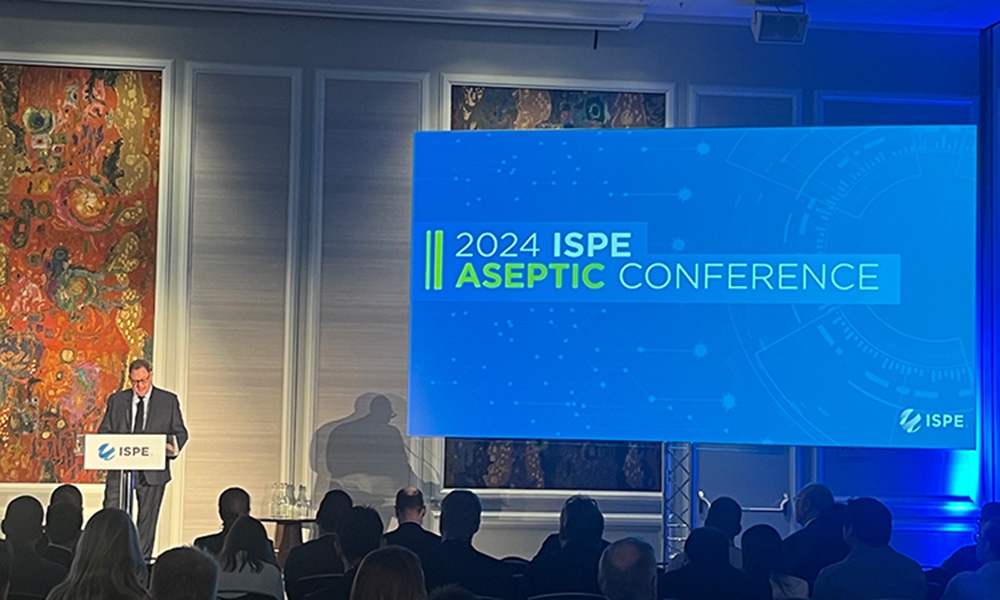2017 Quality Manufacturing Conference - Day 1 Recap

New Format for Stronger Interaction
Fifth Annual ISPE/FDA/PQRI Quality Manufacturing Conference
John Bournas, ISPE CEO and President, welcomed attendees to the fifth annual ISPE/FDA/PQRI Quality Manufacturing Conference, themed “Align Your Company Strategies with Regulatory Priorities,” on Monday, 5 June in Arlington, Virginia US. Bournas introduced ISPE for the benefit of newcomers, and talked about “the robust projects” ISPE has worked on in response to FDA requests. He began by highlighting recent ISPE publications, starting with the Pew ISPE Drug Shortages Report, which explores the relationships between manufacturing, supply chain, and US market forces, and how they contribute to the shortage of sterile injectable products. The ISPE Cultural Excellence Report, a complement to the Society’s Quality Metrics Wave 1 and 2 Reports, shares the vision of quality culture improvements across six dimensions, and outlines a series of approaches, practices, and tools to support implementation of the cultural excellence framework. Both reports are free to ISPE members. Six new Guidance Documents have been published in the first half of the year, Bournas continued. The most recent is the GAMP® Guide to Records and Data Integrity, a companion piece to GAMP 5. ISPE has also debuted a new training webinar, Operationalizing a Quality Metrics Program: Critical Success Factors—and is the only association to have developed an eLearning program around implementation of quality metrics. He closed by announcing upcoming conferences:
- Process Validation and Process Validation Statistics Conferences, 13–15 September in Bethesda, Maryland US
- 2017 Europe Biotechnology Conference, 26–27 September, Dublin, Ireland
- 2017 ISPE Annual Meeting, 29 October–2 November in San Diego, California US (“probably one of the largest Annual Meetings ever,” Bournas said)
- Biopharmaceutical Manufacturing Conference, 4–6 December San Francisco, California, US.
Bournas then introduced the first keynote speaker, François Sallans, PharmD, and Vice President, Quality & Compliance, Chief Quality Officer, Johnson & Johnson.
A 130-Year History of Commitment
François Sallans’ keynote address, “Quality and Innovation: The Johnson & Johnson Experience,” was an inspiring display of one company’s 130-year evolution. Set against the backdrop of the founding fathers’ mission to “to equip surgeons, doctors, and nurses with products that would help reduce germs, and therefore reduce infection in hospitals, and within the community,” Sallans’ address spoke to a vision of the future of health care, and how the healthcare supply chain, and focus on Quality, can drive towards this future through innovation and collaboration. Johnson & Johnson’s impressive series of “firsts,” said Sallans, “started with the needs of our customers, and from those we built an end-to-end partnership between R&D, supply chain, and Quality that transformed lives.” He went on to highlight those firsts: a clean room to create germ-free products, sterilization, and pioneering some of the standards embedded in the FDA’s 1906 Pure Food and Drug Act. Sallans acknowledged that strengthening ties to the customer is paramount in a rapidly changing landscape. “Looking at it through the lens of our customers,” he said, “is key.” Through examples in innovation—bringing to market the first new drug for MDR-TB in 50 years, extending the lives of HIV patients, and developing an EBOLA vaccine—he illustrated a shared commitment to the principles of innovation, science, engineering, and technology. When looking ahead, Sallans spoke about advancements in Industry 4.0, and how the industry can embrace the power of digital. “Big data and technology are enabling rapid innovation,” he said, “and the intersection of science with today's technology is accelerating the pace of that change at a rate we’ve never seen before. Think about it, the healthcare industry moved from ‘Quality is Controlled’ to ‘Quality is Assured,’ to ‘Culture as the Cornerstone of Quality,’ and the industry is now working on ‘Metrics’.” He then considered whether technology and artificial intelligence might make the healthcare industry’s quality systems and operations “agnostic” of culture and variability between individuals. Sallans also noted some examples of the progress he has seen towards the manufacturing of the future, such as:
- Using analytics to optimize and redirect shipping to avoid patient disruption
- Smart packaging that follows a patient’s adherence to required medications, and connecting the package to their smart phones
- Implementing continuous manufacturing and online process analytical technology (PAT) and progressing towards Real Time Release
Finally, Sallans shared the benefits of Johnson & Johnson’s commitment to gender equality noting that “Women have been making things happen at Johnson & Johnson since our founding in 1886, when eight of our first 14 employees were women.” “Since we first hired a woman scientist in 1907, women scientists at our operating companies across the world are helping to develop the innovations that will continue to revolutionize health care in the future.”
Dedicated to Product Quality
Following Sallans’ keynote address, Bournas introduced the day’s second keynote speaker, Michael Kopcha, PhD, RPh, Director, Office of Pharmaceutical Quality (OPQ), CDER, FDA. Kopcha gave a progress update on the OPQ, a new office within CDER that creates a single unit dedicated to product quality. The new structure, established in January 2015, improves oversight of quality throughout the product lifecycle. “Our mission,” said Kopcha, “is to assure that quality medications are available to the public, and our vision is that OPQ will be a global benchmark for regulation of pharmaceutical quality in the next 5–10 years.” The OPQ slogan is “One quality voice” and includes other offices in the FDA and inspectorate. “Pharmaceutical quality,” he added, “is the safety and efficacy of the next dose that the consumer takes.” Two of OPQ objectives are to enhance science- and risk-based regulatory approaches, and transform product quality oversight from a qualitative to a quantitative, expertise-based assessment. Lack of quality, he noted, contributes to drug shortages such as the one of sodium bicarbonate, which was just announced. “We also encourage the adoption of emerging pharmaceutical technology and the development of innovation in manufacturing and manufacturing sciences,” he said. The Emerging Technology Team (ETT) wants to help foster and drive innovation in the pharmaceutical industry—in both design and manufacturing. The team is meant to help us understand new technology so we can regulate it better, he added. The ETT enabled the agency’s first approval of switch from batch to continuous manufacturing for an approved drug. “Continuous manufacturing is not a panacea,” he said, “but it’s a strong step in the right direction.” The OPQ’s new inspection protocol program will bring a lot of good change to the industry, Kopcha stated. “It provides inspectional assessments to support tracking and improvement of performance across pharmaceutical manufacturers and products.” The office also wants to help expedite reviews by creating a consistent, standardized way of doing assessments. Noting that “you have to have a broad mind, think, listen, and collaborate with those around you,” Kopcha explained that OPQ collaborates with global regulatory agencies to benchmark best practices that will help reviews become more efficient, and set a foundation for future collaboration and standardization among industries. “Like any other organization, though, we need to continuously improve,” he concluded. “We’re working together to achieve the vision of ‘a maximally efficient, agile, flexible pharmaceutical manufacturing sector that reliably produces high quality drugs without extensive regulatory oversight.’ The key is ‘without regulatory oversight.’ We need to advance manufacturing sciences to know that quality issues have been addressed. Review must be done on a risk-based basis. Hopefully this dream will be realized in my lifetime.”
Conference Features New Format
This year’s conference presented a unique opportunity for participants to interact directly with industry and regulatory leaders. In response to attendee feedback, this fifth annual event was built around four interactive workshops, with topics chosen from the FDA’s top priority list for 2017:
- Linking Quality to Clinical Relevance
- Modernizing Pharmaceutical Manufacturing through Emerging Technology and Innovation
- Designing Proactive Approaches to Facility and Life Cycle Quality Management
- Implementing Next Steps for Quality Metrics
Sessions were designed to encourage frank discussion and identify real solutions to current challenges. Following a short introduction, participants broke into groups to share perspectives, explore best practices, and discuss the future direction of these important initiatives. Facilitators and regulators circulated around the room, working with each group to answer questions and promote dialogue. One participant acted as scribe and then shared the notes with a facilitator, for compilation. Each workshop topic will have four rotations during the conference, giving participants ample opportunity to attend each one. As questions and concerns emerge in each session, facilitators add them to the content for the next rotation. Key findings and results from each topic will be summarized and presented during the Workshop Reports on Wednesday, 7 June. Workshop: Modernizing Pharmaceutical Manufacturing through Emerging Technology and Innovation This workshop encourages participants to think about the implications of new technology on current manufacturing, regulatory, and corporate processes. The workshop facilitators were:
- John Lepore, PhD, Senior Director, Chemical Engineering, Merck & Co., Inc.
- Frank Montgomery, PhD, Global Head, Regulatory CMC, AstraZeneca
- Gabriella Dahlgren, PhD, Manager, Analytical Sciences and Technology, Advanced Analytics and Design to Value, Janssen Supply Group, LLC
- Sharmista Chatterjee, PhD, Division Director, Office of Process and Facilities and Emerging Technology Team Member, FDA/CDER/OPQ/DPAII
Dr. Dahlgren presented the workshop’s purpose and reason for being. “With the FDA’s new guidance on emerging technologies, the pharmaceutical industry is embracing the opportunity to bring new technologies to life to support robust manufacturing of products,” she said, while acknowledging that manufacturing technologies of this type must be globally accepted. She then listed the workshop’s objectives and provided examples of new technologies that are in the pipeline and in various stages of implementation. Objectives of the workshop:
- Share concerns and perspective on the implementation of new technologies
- Explore how control strategies might be similar and/or different between traditional and new technologies
- Learn and share industry success stories and identify possible new opportunities and best practices
Dr. Chatterjee summarized the FDA’s Emerging Technology Program, making sure to let participants know that “the same ETT representative will be involved in the entire process, as likely will the review team. “ At the end of the workshop, each group reported on their discussion points. Topics discussed included identifying roadblocks to overcome when implementing new technology, primary drivers for new technology, how to ensure an understanding of technology by internal people and health agencies, and similarities and differences in control strategies for new vs. existing technologies. Workshop: Implementing Next Steps for Quality Metrics Steven Greer, External Engagement Leader in Corporate Quality Assurance, Procter & Gamble Company, opened the “Implementing Next Steps for Quality Metrics” workshop by introducing himself and his three co-facilitators:
- Betsy Fritschel, Director at Johnson & Johnson Enterprise Regulatory Compliance
- Dr. Jennifer A. Maguire, Acting Director in the Division of Quality Intelligence, Risk Analysis and Modeling within the Office of Surveillance/OPQ/CDER
- Sarah Pope Miksinski, PhD, Acting Division Director for the Division of New Drug Quality Assessment 2, Office of New Drug Quality Assessment, FDA.
“This needs to be about the patient,” said Greer. “Keep the patient front and center.” The objective for the workshop, he said, was to start conversations between industry and regulators that explored important topics in quality metrics: What’s a vision for a future state? What metrics can drive greater value? Where are companies struggling, and where to they need more FDA encouragement? What do we want from metrics? “In your conversations you’ll also explore other topics,” Greer said, such as: If the revised draft guidance was not what you envisioned, what would you recommend changing? What would be the priority? What came out of the guidance? What didn’t you like, what weren’t you satisfied with? What is your priority for change? “We encourage you to jump in to the conversation,” he added. At the end of the workshop, each group reported the key points that emerged from their conversation. Topics included insight into supplier liability, quality culture, voice of the customer, and standardized vs. individual metrics. As insights were reported, enthusiastic discussion followed. Each group gave its summary to the to the workshop facilitators. They will be presented at the Workshop Outcomes Session on Wednesday, 7 June, at 10:15.



